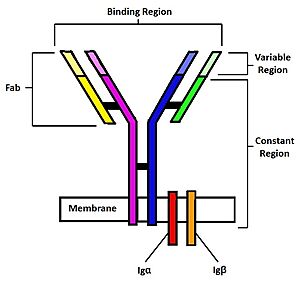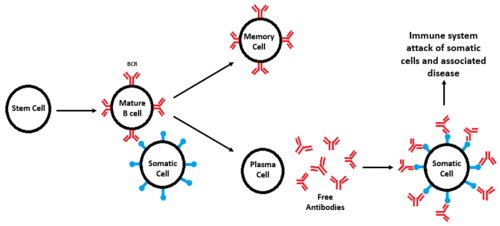Sandbox Reserved 1771
From Proteopedia
(Difference between revisions)
| (3 intermediate revisions not shown.) | |||
| Line 17: | Line 17: | ||
===Transmembrane Interactions=== | ===Transmembrane Interactions=== | ||
| - | Many transmembrane interactions can be found within a IgM BCR. The <scene name='95/952699/Transmembrane_region/ | + | Many transmembrane interactions can be found within a IgM BCR. The <scene name='95/952699/Transmembrane_region/5'>α and β subunits</scene> have numerous interactions that keep them associated with each other. Residue interactions found within the α-β subunits, such as hydrogen bonds, ionic interactions, and hydrophobic interactions between nonpolar residues can be found <scene name='95/952699/Overview_hbonds_fixed/8'>here</scene>. At cellular pH, charged residues found in the transmembrane region strengthen the overall interaction through hydrogen bonds and ionic interactions. For example, <scene name='95/952699/N155_e138_hbonds_fixed/7'>a hydrogen bond</scene> between residues N155 and E138, along with numerous other hydrogen bonds, works to stabilize the α-β chain interactions in the transmembrane region. Further down the chains, <scene name='95/952699/T166_e148_hbonds_fixed/7'>hydrogen bonding</scene> between residues T166 and E148 work to keep the α-β subunit associated with each other. Overall, these hydrogen bonds and ion interactions work to maintain the association of the α-β chains, which allows the BCR to activate an immune response. |
==Structure Summary== | ==Structure Summary== | ||
| Line 26: | Line 26: | ||
===B-cell Formation=== | ===B-cell Formation=== | ||
| - | [[Image: FINAL1.PNG| 500 px|thumb | right| '''Figure 2.''' | + | [[Image: FINAL1.PNG| 500 px|thumb | right| '''Figure 2.''' Diagram of B-cell formation, subsequent divergence, and attack of somatic cells seen in autoimmune diseases. All cell types are labeled and BCRs are shown in red, while antigens are shown in blue. When a defective BCR recognizes a somatic cell instead of a foreign pathogen, an immune response occurs, leading to degradation of tissue and disease.]] |
| - | The formation of B-cells occurs in the bone marrow from hematopoietic stem cells<ref name="Althwaiqeb">Althwaiqeb, S. ''Histology, B Cell Lymphocyte''; StatPearls Publishing, 2023. </ref>. Once formed, B-cell receptors are attached to B-cells through the aid of membrane-bound proteins in bone marrow cells. During this process, gene recombination occurs, which allows unique BCRs to become highly specific to different antigens<ref name="Althwaiqeb">Althwaiqeb, S. ''Histology, B Cell Lymphocyte''; StatPearls Publishing, 2023. </ref>. Once they are formed, [https://en.wikipedia.org/wiki/B_cell B-cells diverge] and become either memory cells or plasma cells. Memory cells still have BCRs and initiate a faster immune response, while plasma cells secrete antibodies | + | The formation of B-cells occurs in the bone marrow from hematopoietic stem cells<ref name="Althwaiqeb">Althwaiqeb, S. ''Histology, B Cell Lymphocyte''; StatPearls Publishing, 2023. </ref>. Once formed, B-cell receptors are attached to B-cells through the aid of membrane-bound proteins in bone marrow cells. During this process, gene recombination occurs, which allows unique BCRs to become highly specific to different antigens<ref name="Althwaiqeb">Althwaiqeb, S. ''Histology, B Cell Lymphocyte''; StatPearls Publishing, 2023. </ref>. Once they are formed, [https://en.wikipedia.org/wiki/B_cell B-cells diverge] and become either memory cells or plasma cells <ref name="Wang Y">Wang Y, Liu J, Burrows PD, Wang JY. B Cell Development and Maturation. Adv Exp Med Biol. 2020;1254:1-22. doi: 10.1007/978-981-15-3532-1_1. PMID: 32323265.</ref>. Memory cells still have BCRs and initiate a faster immune response during a secondary infection, while plasma cells secrete antibodies for immediate response to foreign antigens <ref name="Althwaiqeb">Althwaiqeb, S. ''Histology, B Cell Lymphocyte''; StatPearls Publishing, 2023. </ref>. |
===Disease=== | ===Disease=== | ||
| - | B-cells and their respective receptors play an important role in the immune response. Misregulation can lead to damaging consequences. [https://en.wikipedia.org/wiki/Autoimmune_disease Autoimmune diseases] develop when somatic cells are recognized as foreign antigens and the body tries to eliminate them <Ref name="Yanaba K">Yanaba K, Bouaziz JD, Matsushita T, Magro CM, St Clair EW, Tedder TF. B-lymphocyte contributions to human autoimmune disease. Immunol Rev. 2008 Jun;223:284-99. doi: 10.1111/j.1600-065X.2008.00646.x. PMID: 18613843. </Ref>. B-cell receptors are hypothesized to be an essential part of autoimmune disease development due to BCR function and role in the immune systems. In autoimmune diseases, BCRs improperly recognize somatic cells from different tissues and elicit the production of [https://en.wikipedia.org/wiki/Autoantibody autoantibodies]<Ref name="Yanaba K">Yanaba K, Bouaziz JD, Matsushita T, Magro CM, St Clair EW, Tedder TF. B-lymphocyte contributions to human autoimmune disease. Immunol Rev. 2008 Jun;223:284-99. doi: 10.1111/j.1600-065X.2008.00646.x. PMID: 18613843. </Ref>, causing the destruction of these cell types. Examples of these diseases include [https://en.wikipedia.org/wiki/Rheumatoid_arthritis rheumatoid arthritis] where the lining of joints is targeted and degraded, [https://en.wikipedia.org/wiki/Multiple_sclerosis multiple sclerosis] which targets the myelin sheath that surrounds nerve cells, [https://en.wikipedia.org/wiki/Type_1_diabetes type 1 diabetes mellitus] where the insulin producing cells are targeted for destruction, and [https://en.wikipedia.org/wiki/Lupus systematic lupus erythematosus] where multiple organ systems are targeted (skin, brain, lungs, and kidneys are common targets) <Ref name="Yanaba K">Yanaba K, Bouaziz JD, Matsushita T, Magro CM, St Clair EW, Tedder TF. B-lymphocyte contributions to human autoimmune disease. Immunol Rev. 2008 Jun;223:284-99. doi: 10.1111/j.1600-065X.2008.00646.x. PMID: 18613843. </Ref>. | + | B-cells and their respective receptors play an important role in the immune response. Misregulation can lead to damaging consequences. [https://en.wikipedia.org/wiki/Autoimmune_disease Autoimmune diseases] develop when somatic cells are recognized as foreign antigens and the body tries to eliminate them <Ref name="Yanaba K">Yanaba K, Bouaziz JD, Matsushita T, Magro CM, St Clair EW, Tedder TF. B-lymphocyte contributions to human autoimmune disease. Immunol Rev. 2008 Jun;223:284-99. doi: 10.1111/j.1600-065X.2008.00646.x. PMID: 18613843. </Ref> (figure 2). B-cell receptors are hypothesized to be an essential part of autoimmune disease development due to BCR function and role in the immune systems. In autoimmune diseases, BCRs improperly recognize somatic cells from different tissues and elicit the production of [https://en.wikipedia.org/wiki/Autoantibody autoantibodies]<Ref name="Yanaba K">Yanaba K, Bouaziz JD, Matsushita T, Magro CM, St Clair EW, Tedder TF. B-lymphocyte contributions to human autoimmune disease. Immunol Rev. 2008 Jun;223:284-99. doi: 10.1111/j.1600-065X.2008.00646.x. PMID: 18613843. </Ref>, causing the destruction of these cell types. Examples of these diseases include [https://en.wikipedia.org/wiki/Rheumatoid_arthritis rheumatoid arthritis] where the lining of joints is targeted and degraded, [https://en.wikipedia.org/wiki/Multiple_sclerosis multiple sclerosis] which targets the myelin sheath that surrounds nerve cells, [https://en.wikipedia.org/wiki/Type_1_diabetes type 1 diabetes mellitus] where the insulin producing cells are targeted for destruction, and [https://en.wikipedia.org/wiki/Lupus systematic lupus erythematosus] where multiple organ systems are targeted (skin, brain, lungs, and kidneys are common targets) <Ref name="Yanaba K">Yanaba K, Bouaziz JD, Matsushita T, Magro CM, St Clair EW, Tedder TF. B-lymphocyte contributions to human autoimmune disease. Immunol Rev. 2008 Jun;223:284-99. doi: 10.1111/j.1600-065X.2008.00646.x. PMID: 18613843. </Ref>. |
===Therapeutics=== | ===Therapeutics=== | ||
Current revision
| This Sandbox is Reserved from February 27 through August 31, 2023 for use in the course CH462 Biochemistry II taught by R. Jeremy Johnson at the Butler University, Indianapolis, USA. This reservation includes Sandbox Reserved 1765 through Sandbox Reserved 1795. |
To get started:
More help: Help:Editing |
IgM B-cell Receptor
| |||||||||||
References
- ↑ Robinson R. Distinct B cell receptor functions are determined by phosphorylation. PLoS Biol. 2006 Jul;4(7):e231. doi: 10.1371/journal.pbio.0040231. Epub 2006 May 30. PMID: 20076604; PMCID: PMC1470464.
- ↑ Seda, Valcav. Mraz, Marek. B-cell receptor signalling and its crosstalk with other pathways in normal and malignant cells. European Journal of Haematology. 2014 Aug 1;94 (3):193-205. [doi:10.1111/ejh.12427. Epub 2015 Feb 25.]
- ↑ 3.0 3.1 3.2 3.3 3.4 3.5 Su Q, Chen M, Shi Y, Zhang X, Huang G, Huang B, Liu D, Liu Z, Shi Y. Cryo-EM structure of the human IgM B cell receptor. Science. 2022 Aug 19;377(6608):875-880. [doi: 10.1126/science.abo3923. Epub 2022 Aug 18. PMID: 35981043.]
- ↑ 4.0 4.1 4.2 4.3 4.4 Janeway CA Jr, Travers P, Walport M, et al. Immunobiology: The Immune System in Health and Disease. 5th edition. New York: Garland Science; 2001.
- ↑ Ma X, Zhu Y, Dong D, Chen Y, Wang S, Yang D, Ma Z, Zhang A, Zhang F, Guo C, Huang Z. Cryo-EM structures of two human B cell receptor isotypes. Science. 2022 Aug 19;377(6608):880-885. [doi: 10.1126/science.abo3828. Epub 2022 Aug 18. PMID: 35981028]
- ↑ Zhixun Shen, Sichen Liu, Xinxin Li, Zhengpeng Wan, Youxiang Mao, Chunlai Chen, Wanli Liu (2019) Conformational change within the extracellular domain of B cell receptor in B cell activation upon antigen binding eLife 8:e42271. Doi: https://doi.org/10.7554/eLife.42271
- ↑ 7.0 7.1 Tolar P, Pierce SK. Unveiling the B cell receptor structure. Science. 2022 Aug 19;377(6608):819-820. [doi: 10.1126/science.add8065. Epub 2022 Aug 18. PMID: 35981020.]
- ↑ 8.0 8.1 Zhixun Shen, Sichen Liu, Xinxin Li, Zhengpeng Wan, Youxiang Mao, Chunlai Chen, Wanli Liu. July 2019. Conformational change within the extracellular domain of B cell receptor in B cell activation upon antigen binding. DOI: https://doi.org/10.7554/eLife.42271.
- ↑ 9.0 9.1 9.2 Althwaiqeb, S. Histology, B Cell Lymphocyte; StatPearls Publishing, 2023.
- ↑ Wang Y, Liu J, Burrows PD, Wang JY. B Cell Development and Maturation. Adv Exp Med Biol. 2020;1254:1-22. doi: 10.1007/978-981-15-3532-1_1. PMID: 32323265.
- ↑ 11.0 11.1 11.2 Yanaba K, Bouaziz JD, Matsushita T, Magro CM, St Clair EW, Tedder TF. B-lymphocyte contributions to human autoimmune disease. Immunol Rev. 2008 Jun;223:284-99. doi: 10.1111/j.1600-065X.2008.00646.x. PMID: 18613843.
- ↑ 12.0 12.1 Chandrashekara S. The treatment strategies of autoimmune disease may need a different approach from conventional protocol: a review. Indian J Pharmacol. 2012 Nov-Dec;44(6):665-71. doi: 10.4103/0253-7613.103235. PMID: 23248391; PMCID: PMC3523489.
- ↑ Lateef A, Petri M. Hormone replacement and contraceptive therapy in autoimmune diseases. J Autoimmun. 2012 May;38(2-3):J170-6. doi: 10.1016/j.jaut.2011.11.002. Epub 2012 Jan 18. PMID: 22261500.
- ↑ Dupuis, M.L., Pagano, M.T., Pierdominici, M. et al. The role of vitamin D in autoimmune diseases: could sex make the difference?. Biol Sex Differ 12, 12 (2021). https://doi.org/10.1186/s13293-021-00358-3.
- ↑ Shu SA, Wang J, Tao MH, Leung PS. Gene Therapy for Autoimmune Disease. Clin Rev Allergy Immunol. 2015 Oct;49(2):163-76. doi: 10.1007/s12016-014-8451-x. PMID: 25277817.
Student Contributors
- Joel Wadas
- Olivia Gooch
- Delaney Lupoi


